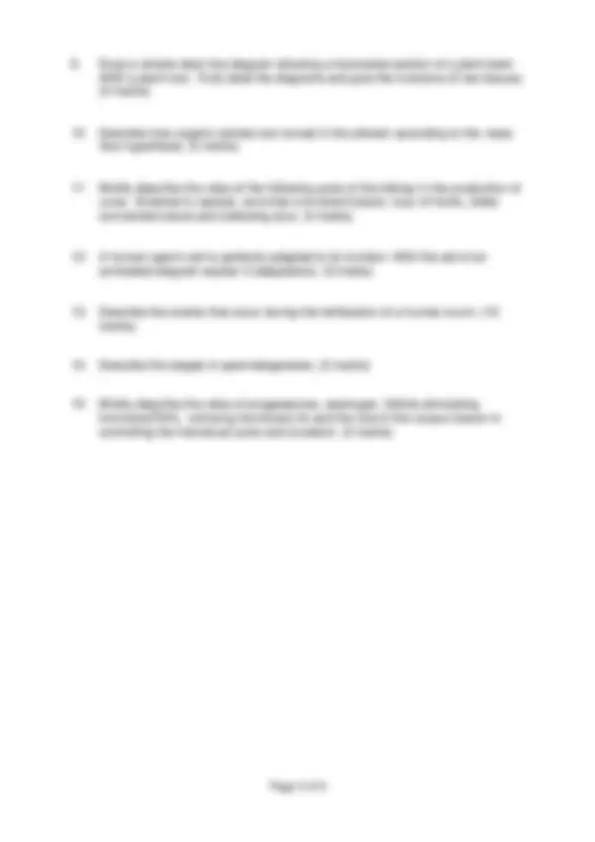



Study with the several resources on Docsity

Earn points by helping other students or get them with a premium plan


Prepare for your exams
Study with the several resources on Docsity

Earn points to download
Earn points by helping other students or get them with a premium plan
Community
Ask the community for help and clear up your study doubts
Discover the best universities in your country according to Docsity users
Free resources
Download our free guides on studying techniques, anxiety management strategies, and thesis advice from Docsity tutors
The questions and instructions for a university-level biology examination focusing on the organization and function of biological systems. Topics covered include the circulatory system, heart function, cardiac cycle control, hemoglobin dissociation curves, carbon dioxide transport, transpiration, plant anatomy, phloem transport, kidney function, human sperm, fertilization, and menstrual cycle hormones.
Typology: Exams
1 / 2

This page cannot be seen from the preview
Don't miss anything!


Page 1 of 2
ARHOLIADAU EXAMINATIONS
SEMESTER 2 EXAMINATIONS 2010
IBERS (BIOLOGICAL SCIENCES)
BS00510 BIOLOGICAL ORGANISATION AND FUNCTION
TIME ALLOWED: TWO HOURS
ANSWER ALL QUESTIONS
ANNOTATED DRAWINGS OR SKETCHES CAN BE USED AS PART OF ANY ANSWER
1 With the aid of simple, labelled diagrams, describe the different types of circulatory systems found in animals. What are the advantages of the type of circulatory system found in man. (10 marks)
2 Describe the circulation of blood through the human heart, referring to the names of the chambers, blood vessels and valves. (10 marks)
3 How is the cardiac cycle controlled in man. (10 marks)
4 Draw a graph to show the dissociation curve, for human haemoglobin. Draw two further dissociation curves on the same diagram to show: (i) the position of foetal haemoglobin (ii) the Bohr effect. Fully label the graph. (5 marks)
5 How is carbon dioxide carried by the blood? (5 marks)
6 Explain how negative feedback regulates blood sugar levels. (A fully annotated diagram would be sufficient) (10 marks)
7 Describe what is meant by ‘ the transpiration pull and the Cohesion-tension theory’. (5 marks)
8 What is the effect of light, humidity and wind speed on the rate of transpiration? (5 marks)
Page 2 of 2
9 Draw a simple clear line diagram showing a transverse section of a plant stem AND a plant root. Fully label the diagrams and give the functions of two tissues. (5 marks)
10 Describe how organic solutes are moved in the phloem according to the mass flow hypothesis. (5 marks)
11 Briefly describe the roles of the following parts of the kidney in the production of urine: Bowman’s capsule, proximal convoluted tubule, loop of Henle, distal convoluted tubule and collecting duct. (5 marks)
12 A human sperm cell is perfectly adapted to its function. With the aid of an annotated diagram explain 3 adaptations. (5 marks)
13 Describe the events that occur during the fertilization of a human ovum. ( marks)
14 Describe the stages in spermatogenesis. (5 marks)
15 Briefly describe the roles of progesterone, oestrogen, follicle stimulating hormone(FSH), lutinizing hormone(LH) and the role of the corpus luteum in controlling the menstrual cycle and ovulation. (5 marks)